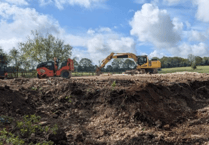Just now all local politicians are gearing up for the district council elections in May. This led me to ponder why the turnout is so low for local elections.
At our last local election of East Hampshire District Council councillors in 2019, the overall turnout was 40 per cent. So fewer than half the voters voted.
The figures for the individual wards of East Hampshire ranged from 27 per cent to 53 per cent.
The winning candidate in the lowest turnout ward was elected with votes from just 12.5 per cent of the electorate.
This candidate needed only 149 votes to become the new councillor.
Local elections do not get the wall-to-wall news coverage of general elections. Lack of awareness must play a big role in low turnout.
But I wonder if it is the major reason.
East Hampshire has three tiers of local government.
It is part of Hampshire County Council. Then there is the district council, elsewhere sometimes called borough or city council.
Then there is the lowest level of local authority, the parish or town council.
And East Hampshire is even more confusing than most districts.
Planning is normally the job of a district council, but East Hampshire is partly in and partly out of the South Downs National Park (SDNP).
The SDNP’s authority makes the planning decisions for the area within the park.
This body is unelected and answers to no voters.
So it is difficult to understand what services each tier is responsible for.
This level of confusion means voters won’t be sure what they are voting for.
District councillors first and foremost deal with local issues. But the district council can also have a much wider impact.
‘Think global – act local’ has always been what Greens try to do.
Climate change is certainly a global issue. The district council can help. It handles the help the government offers for home insulation.
Good insulation means a cosy home that’s cheaper to run. It also reduces East Hampshire’s carbon footprint.
Our district council could take a much more active role.
It should know the state of the housing stock in East Hampshire. It should know where the help is most needed. It could target information and help at these areas.
It could even bring in its own schemes or to make houses more environmentally friendly. It could offer ‘green’ loans with a payback time similar to mortgages.
It could make these loans to the house rather than the householder – it already raises council tax from the house.
The householder pays the tax until they move. Then the new householder takes over. The same system could be applied to these insulation loans.
EHDC also has an investment fund of £200million, of which five per cent is set aside for renewable energy investment.
To date, none of these available funds have been invested – perhaps an indication of their attitude to the climate change.
Green councillors will work hard on local issues and always will.
But we look at a broader picture, too. We can reduce your energy bills and help save our planet. All you need to do is vote Green.
By Ian James
East Hampshire Green Party spokesman





Comments
This article has no comments yet. Be the first to leave a comment.